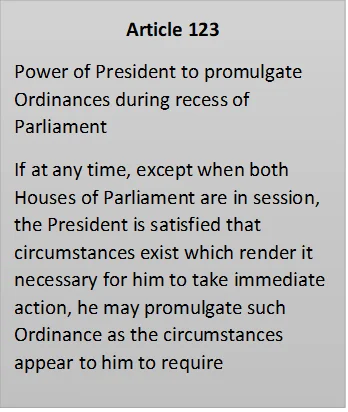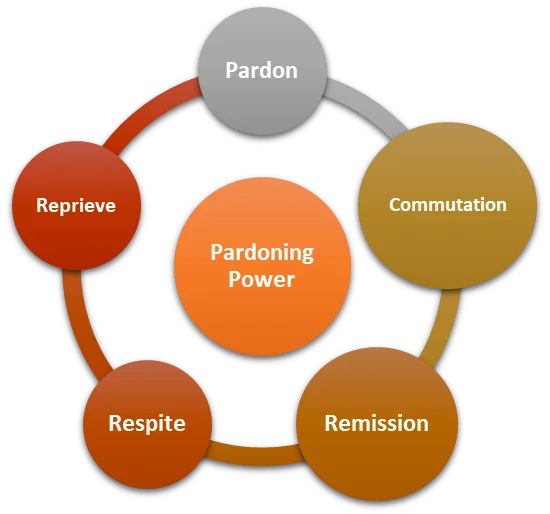The President of India holds significant powers and functions as outlined in the Constitution. This includes the ability to issue ordinances, grant pardons, and exercise legislative oversight. Understanding these powers is essential for grasping the President’s role in governance and the legal framework of India.
Powers and Functions of the President of India: An Overview
Ordinance Making Power
- Ordinance-Making Power of the President: Article 123 of the Constitution confers the President the authority to promulgate ordinances during the recess of Parliament.
- These ordinances possess the same legal force and effect as acts of Parliament but are essentially temporary laws.
- Limitations on Ordinance-Making Power: The President’s exercise of this ordinance-making power is subject to following limitations:

- At Least One House in Recess: Ordinarily, the President can promulgate an ordinance only when both the Houses of the Parliament are not in session or when either of the two Houses is not in session.
- Ordinance Issuance with One House in Session: However, an ordinance can be issued when only one House is in session, as a law can only be enacted with the approval of both Houses.
- Invalidity of Ordinance: An ordinance created when both Houses are in session is invalid, underscoring that the President’s ordinance-making power is not a parallel legislative authority.
- Immediate Action Requirement: The President may issue an ordinance only when he is satisfied that circumstances necessitate immediate action.
- Legal Challenge to Ordinance Issuance: Notably, the President’s decision to issue an ordinance can be legally challenged in a court on the grounds of malafide.
- Deliberate Prorogation and Legislative Authority: If it can be demonstrated that the President has prorogued one or both Houses of Parliament deliberately to promulgate an ordinance on a contentious matter, thereby bypassing parliamentary decision and undermining the authority of Parliament, the decision to issue the ordinance can be questioned.
- Judicial Scrutiny Post-Amendments: The 38th Constitutional Amendment Act of 1975 initially rendered the President’s satisfaction final and beyond judicial review, but the 44th Constitutional Amendment Act of 1978 removed this provision.
- Consequently, the President’s satisfaction is subject to judicial scrutiny on the basis of malafide.
- Scope and Constitutional Limitations: The ordinance-making power of the President extends to all matters that Parliament can legislate on, except for the duration aspect.
- This means an ordinance can be issued only on subjects over which Parliament can make laws and is subject to the same constitutional limitations as an act of the Parliament.
- Consequently, an ordinance cannot infringe upon or curtail any fundamental rights.
- The President can’t promulgate ordinances with respect to Constitutional amendment.
- Parliamentary Oversight: Every ordinance issued by the President during Parliament’s recess must be presented before both Houses of Parliament when they reconvene.
- Transformation into Act: If the ordinance receives approval from both the Houses, it becomes an act.
- Duration and Expiry of Ordinance: If Parliament takes no action, the ordinance ceases to have legal effect six weeks from Parliament’s reconvening.
- Early Cessation of Ordinance: The ordinance may cease to have effect earlier than the specified six-week period if both the Houses of Parliament pass resolutions disapproving it.
- Counting the Six-Week Period: If Parliament is convened on different dates, the six-week period is counted from the later of those dates.
- Maximum Duration of Ordinance: This means that the maximum duration of an ordinance can be six months and six weeks in the absence of parliamentary approval (six months being the maximum interval between two parliamentary sessions).
- Validity of Actions Under Lapsed Ordinance: If an ordinance lapses without being presented before Parliament, actions undertaken under it, before it lapses, remain fully valid and effective.
Enroll now for UPSC Online Course
Presidential Authority and Withdrawal
- Authority to Withdraw Ordinance: The President retains the ability to withdraw an ordinance at any time.
- Non-Discretionary Power: However, the power to promulgate or withdraw an ordinance is not discretionary and can only be exercised on the advice of the council of ministers led by the Prime Minister.
- Retrospective Nature and Scope: Similar to other forms of legislation, an ordinance can be retrospective, coming into effect from a past date.
- It may also modify or repeal an existing act of Parliament or another ordinance.
- Furthermore, it can amend tax laws.
- However, it cannot be used to amend the Constitution.
| Unique Feature in Indian Constitution
The ordinance-making power of the President in India is distinct and not found in most democratic constitutions worldwide, including the United States and the United Kingdom. Dr. B.R. Ambedkar, during the Constituent Assembly debates, justified this power as a mechanism to enable the Executive to address situations that may suddenly and urgently arise when the Parliament is not in session. It’s important to note that this power does not necessarily relate to a national emergency as envisioned in Article 352. The President can issue an ordinance even in the absence of war, external aggression, or armed rebellion. |
Transparency Requirement
- Requirement for Legislative Statement: The rules of Lok Sabha mandate that when a bill is introduced to replace an ordinance, a statement explaining the circumstances necessitating immediate legislation by ordinance must be presented before the House.
- Absence of Legal Challenge: To date, no legal case has been brought before the Supreme Court regarding the President’s promulgation of ordinances.
Relevant Judicial Ruling
- D.C. Wadhwa Case (1987): The Supreme Court’s judgement in the D.C. Wadhwa case (1987) is noteworthy.
- In this case, the court observed that between 1967 and 1981, the Governor of Bihar promulgated 256 ordinances, and these ordinances remained in force for durations ranging from one to fourteen years due to repeated promulgations.
- Krishna Kumar Case (2017): In the Krishna Kumar Case, 2017 the apex court agreed that the wisdom of an ordinance can be questioned in the court of law.
- Also, the court said that the decisions taken under a lapsed ordinance can be reversed.
- Violations of Constitutional Authority: The court held that the repeated re-promulgation of ordinances without any effort to have the bills passed by the legislative assembly would violate the Constitution.
- Ordinances subjected to such re-promulgation could be declared invalid.
- The court emphasised that the extraordinary power of law-making through ordinances should not be used as a substitute for the legislative power of the state legislature.

Pardoning Power of the President
- President’s Pardoning Power: Article 72 of the Constitution empowers the President of India to grant pardons to individuals who have been tried and convicted of various offences under specific conditions:
- When the punishment or sentence is related to an offence against Union Law.
- When the punishment or sentence is passed by a court martial (military court).
- When the sentence is one of death.
- Nature of the Pardoning Power: It is important to note that the President’s pardoning power is not a judicial function but an executive authority. While exercising this power, the President does not act as a court of appeal.
- Key Objectives of the Pardoning Authority: The key objectives of granting this authority to the President are two fold:
- To provide a means to correct any judicial errors that may have occurred in the application of the law, and
- To offer relief from sentences that are deemed unduly harsh by the President.
- Forms of Clemency in the President’s Pardoning Power: The President’s pardoning power encompasses several forms of clemency:
-
- Pardon: This entails a complete absolution of the individual from the crime, allowing them to resume their life as an ordinary citizen.
- Commutation: It involves changing the type of punishment imposed on the guilty to a less severe one. For instance, the death penalty may be commuted to a life sentence.
- Reprieve: This grants a delay in the execution of a sentence, often in the case of a death sentence, allowing the individual time to apply for a Presidential Pardon or seek other legal remedies to prove their innocence or demonstrate rehabilitation.
- Respite: Respite involves reducing the severity or duration of punishment due to special circumstances, such as pregnancy or a mental condition.
- Remission: Remission pertains to altering the duration of the punishment without changing its nature, for instance, reducing a twenty-year rigorous imprisonment to ten years.
Principles laid down by the Supreme Court regarding the pardoning power of the President
- Discretion in Pardoning Power: The Supreme Court, in the landmark case of Maru Ram v. Union of India has categorically held that the President cannot exercise his personal discretion in this matter; rather, he functions on the aid and advice of Council of Ministers.
- Right to Oral Hearing: The petitioner has no right to demand an oral hearing by the President.
- Union Cabinet’s Role: The pardoning power has to be exercised on the advice of the Union Cabinet.
- Obligation to Provide Reasons: The President is not bound to provide any reasons for his decision.
- Examination of Evidence: The President can examine the evidence of the case afresh and may make different interpretations than the court’s judgement.
- Relief from Harsh Sentences: The President can provide relief from an evident mistake or a sentence that he considers unduly harsh.
- Judicial Review Limitations: This power does not come under the purview of judicial review unless the decision is irrational, arbitrary, mala fide or discriminatory.
- Subsequent Petitions: After rejection of an earlier petition for mercy, stay can not be obtained by filing another petition.
President’s vs Governor’s Pardoning Power
- Key Distinctions in Pardoning Power: Under Article 161 of the Constitution, the Governor of a state also possesses the authority to grant pardons, reprieves, respites, and remissions of punishment or suspend, remit, and commute the sentence of an individual convicted of an offence against state law.
- However, there are two key distinctions in the governor’s pardoning power as compared to that of the President:
| President’s Pardoning Power | Governor’s Pardoning Power |
|
|
|
|
|
|
|
|
Enroll now for UPSC Online Course
| Must Read | |
| Current Affairs | Editorial Analysis |
| Upsc Notes | Upsc Blogs |
| NCERT Notes | Free Main Answer Writing |
Conclusion
In summary, the President’s powers, including ordinance-making and pardoning, are critical for maintaining the balance between the executive and legislative branches.
- While these powers are substantial, they also come with limitations and judicial oversight.
- This ensures that the President’s authority is exercised responsibly within the democratic framework of the country.
Sign up for the PWOnlyIAS Online Course by Physics Wallah and start your journey to IAS success today!
| Related Articles | |
| President of India | Major Constitutional Amendments |
| Fundamental Rights (Article 12-35) | Constitution: A Living Document |

 GS Foundation
GS Foundation Optional Course
Optional Course Combo Courses
Combo Courses Degree Program
Degree Program









